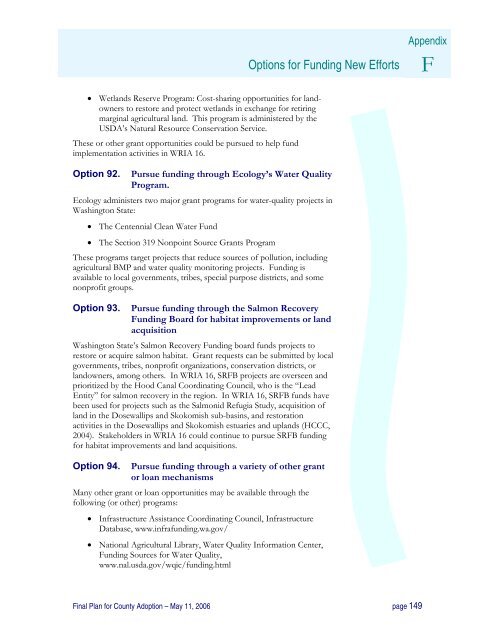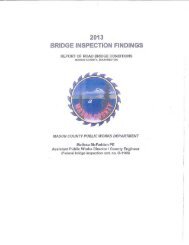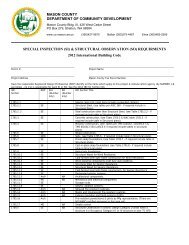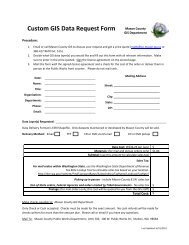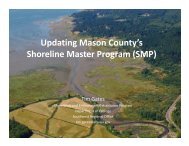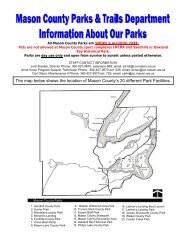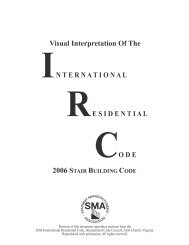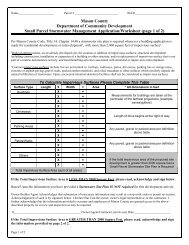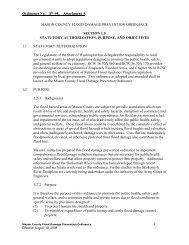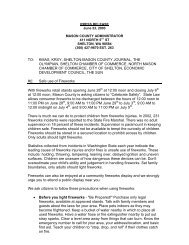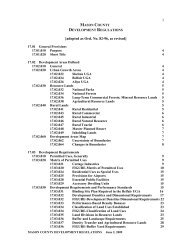Watershed Management Plan - Mason County
Watershed Management Plan - Mason County
Watershed Management Plan - Mason County
Create successful ePaper yourself
Turn your PDF publications into a flip-book with our unique Google optimized e-Paper software.
Options for Funding New Efforts<br />
Appendix<br />
F<br />
• Wetlands Reserve Program: Cost-sharing opportunities for landowners<br />
to restore and protect wetlands in exchange for retiring<br />
marginal agricultural land. This program is administered by the<br />
USDA’s Natural Resource Conservation Service.<br />
These or other grant opportunities could be pursued to help fund<br />
implementation activities in WRIA 16.<br />
Option 92.<br />
Pursue funding through Ecology’s Water Quality<br />
Program.<br />
Ecology administers two major grant programs for water-quality projects in<br />
Washington State:<br />
• The Centennial Clean Water Fund<br />
• The Section 319 Nonpoint Source Grants Program<br />
These programs target projects that reduce sources of pollution, including<br />
agricultural BMP and water quality monitoring projects. Funding is<br />
available to local governments, tribes, special purpose districts, and some<br />
nonprofit groups.<br />
Option 93.<br />
Pursue funding through the Salmon Recovery<br />
Funding Board for habitat improvements or land<br />
acquisition<br />
Washington State’s Salmon Recovery Funding board funds projects to<br />
restore or acquire salmon habitat. Grant requests can be submitted by local<br />
governments, tribes, nonprofit organizations, conservation districts, or<br />
landowners, among others. In WRIA 16, SRFB projects are overseen and<br />
prioritized by the Hood Canal Coordinating Council, who is the “Lead<br />
Entity” for salmon recovery in the region. In WRIA 16, SRFB funds have<br />
been used for projects such as the Salmonid Refugia Study, acquisition of<br />
land in the Dosewallips and Skokomish sub-basins, and restoration<br />
activities in the Dosewallips and Skokomish estuaries and uplands (HCCC,<br />
2004). Stakeholders in WRIA 16 could continue to pursue SRFB funding<br />
for habitat improvements and land acquisitions.<br />
Option 94.<br />
Pursue funding through a variety of other grant<br />
or loan mechanisms<br />
Many other grant or loan opportunities may be available through the<br />
following (or other) programs:<br />
• Infrastructure Assistance Coordinating Council, Infrastructure<br />
Database, www.infrafunding.wa.gov/<br />
• National Agricultural Library, Water Quality Information Center,<br />
Funding Sources for Water Quality,<br />
www.nal.usda.gov/wqic/funding.html<br />
Final <strong>Plan</strong> for <strong>County</strong> Adoption – May 11, 2006 page 149


